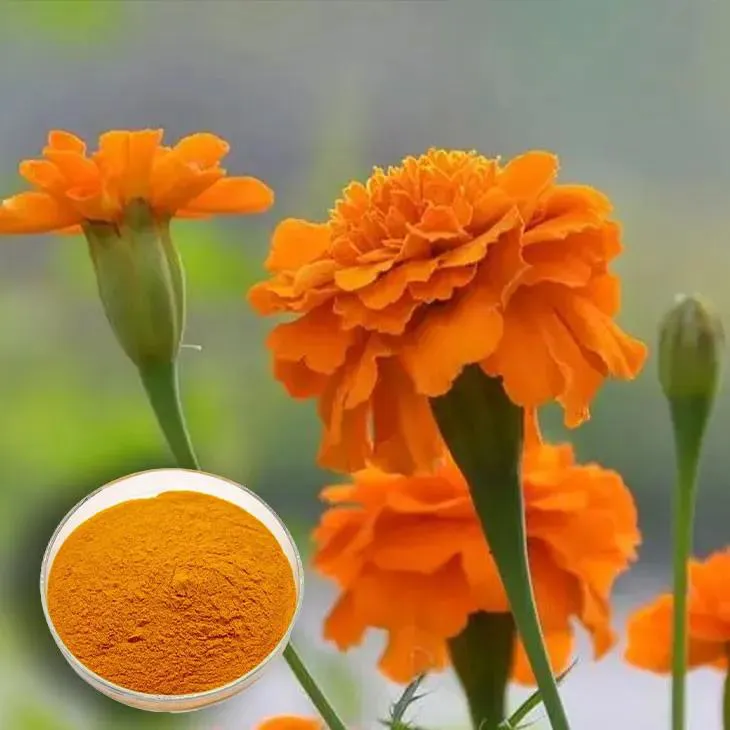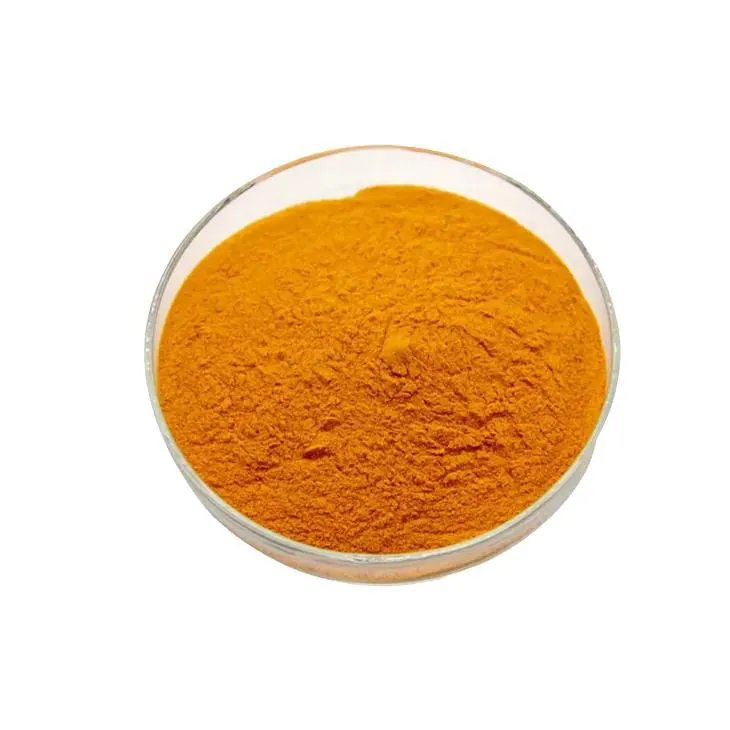- 0086-571-85302990
- sales@greenskybio.com
Best Types of Marigold Extract: A Guide to Selecting the Best Marigold Extract
2024-11-11

Introduction
Marigold Extract has gained significant popularity in recent years due to its numerous health benefits. It is rich in various bioactive compounds, making it a valuable addition to many products, including dietary supplements, cosmetics, and pharmaceuticals. However, with the increasing availability of Marigold Extract in the market, it has become crucial to understand how to select the finest one. This article aims to provide comprehensive information on the different types of Marigold Extract and the factors to consider when making a choice.

Types of Marigold Extract
1. Oleoresin
Oleoresin marigold extract is a concentrated form that contains both the oil - soluble and resinous components of the marigold. It is often used in the food industry as a natural colorant due to its high content of carotenoids. The extraction process typically involves using solvents to obtain a highly concentrated product. One advantage of oleoresin extract is its long shelf - life, which makes it suitable for various applications where stability is required.
2. Powdered Extract
The powdered marigold extract is obtained by drying and grinding the marigold plant material after extraction. This form is popular in the supplement industry as it can be easily incorporated into capsules or tablets. Powdered extracts can vary in their concentration levels, and it is important to check the label for the content of key compounds such as lutein and zeaxanthin. Additionally, the quality of the powder can be affected by factors such as the extraction method and the source of the marigold.
3. Liquid Extract
Liquid marigold extract is another form available in the market. It is often used in topical applications such as cosmetics and skincare products. The liquid form allows for easy application and absorption into the skin. However, it may require additional preservatives to maintain its stability, especially if it is not used immediately. The concentration of active ingredients in liquid extracts can also vary, so it is essential to check the product specifications.

Key Factors in Selecting Marigold Extract
1. Carotenoid Content
The content of carotenoids, especially lutein and zeaxanthin, is a crucial factor when choosing marigold extract. These carotenoids are known for their beneficial effects on vision health. Lutein and zeaxanthin are concentrated in the macula of the eye, where they help protect against harmful blue light and oxidative stress. Higher levels of these carotenoids in the marigold extract indicate a more potent product for maintaining good eye health. When evaluating different marigold extracts, look for products that clearly state the amount of lutein and zeaxanthin per serving or unit of measurement.
2. Purity
Purity of the marigold extract is of utmost importance. Impurities in the extract can not only affect its efficacy but also pose potential safety risks. High - quality marigold extracts should be free from contaminants such as heavy metals, pesticides, and other harmful substances. Analyzing the product label for information on purity grades and any certifications related to purity can help ensure that you are choosing a safe and effective product. Additionally, the extraction technique used can influence the purity of the extract. For example, some extraction methods may be more likely to introduce impurities compared to others.
3. Origin of the Marigold
The origin of the marigold used in the extract can have an impact on its quality. Marigolds grown in different regions may vary in their chemical composition due to differences in soil quality, climate, and cultivation practices. For example, marigolds grown in regions with rich soil and optimal sunlight exposure may contain higher levels of beneficial compounds. When possible, choose marigold extracts sourced from regions known for their high - quality marigold production. Some regions may also have stricter regulations regarding agricultural practices, which can further ensure the quality of the raw material.
4. Extraction Technique
The extraction technique used to obtain the marigold extract plays a significant role in determining its quality. Different extraction methods can result in extracts with varying levels of purity, concentration, and bioactivity. Some common extraction techniques include solvent extraction, supercritical fluid extraction, and steam distillation. Solvent extraction is widely used but may leave behind traces of solvents if not properly processed. Supercritical fluid extraction, on the other hand, can produce a cleaner and more pure extract as it uses carbon dioxide under supercritical conditions. Steam distillation is mainly used for obtaining essential oils from marigolds and may not be as effective for extracting carotenoids. Understanding the extraction technique used can help you assess the quality of the marigold extract.

Evaluating Product Labels
When selecting a marigold extract, carefully examining the product label is essential. The label should provide valuable information about the product, allowing you to make an informed decision.
1. Ingredient List
The ingredient list should clearly state that the product contains marigold extract. It may also include other ingredients such as fillers, binders, or preservatives in the case of supplements or additives in the case of cosmetics. Be aware of any potential allergens or substances that you may want to avoid. For example, if you are allergic to certain solvents, check if the extract was obtained using that solvent.
2. Nutritional Information
For marigold extracts sold as dietary supplements, the label should provide nutritional information. This includes the amount of key compounds such as lutein and zeaxanthin per serving. It may also include information on other nutrients or bioactive substances present in the extract. Comparing the nutritional information of different products can help you choose the one that best meets your health needs.
3. Purity and Quality Indicators
Look for indicators of purity and quality on the label. This may include statements about the absence of contaminants such as heavy metals and pesticides. Some products may also display certifications or quality marks that attest to their purity and quality. For example, a product may be certified organic, which can be an indication of a higher - quality raw material and more environmentally friendly production process.
4. Origin and Sourcing Information
The label may provide information about the origin of the marigold used in the extract. As mentioned earlier, the origin can be an important factor in determining the quality of the extract. Additionally, some labels may include information about the sourcing practices, such as whether the marigolds were sustainably sourced or grown using organic methods.

Applications of Marigold Extract
1. Vision Health
Marigold extract, particularly due to its lutein and zeaxanthin content, is widely recognized for its benefits in vision health. These carotenoids help protect the eyes from age - related macular degeneration, cataracts, and other eye diseases. Regular consumption of marigold extract - containing supplements or foods rich in marigold extract can help maintain healthy eyesight, especially in the aging population.
2. Skin Health
In the realm of skin health, marigold extract has antioxidant and anti - inflammatory properties. It can be used in skincare products to help reduce inflammation, soothe irritated skin, and protect against oxidative damage caused by environmental factors such as UV radiation. Liquid marigold extract is often incorporated into creams, lotions, and serums for topical application to the skin.
3. Food Coloring
The oleoresin form of marigold extract is commonly used as a food coloring agent. It provides a natural yellow - orange color to various food products, including baked goods, dairy products, and beverages. As a natural alternative to synthetic food colorants, marigold extract is preferred by many consumers who are seeking more natural and healthy options in their food choices.
Conclusion
Selecting the finest marigold extract requires careful consideration of several factors. The type of extract, carotenoid content, purity, origin, extraction technique, and the information provided on the product label all play important roles in determining the quality and suitability of the marigold extract for your specific needs. Whether you are using it for vision health, skin health, or as a food coloring agent, taking the time to research and evaluate different marigold extracts will ensure that you choose a product that is both effective and safe. By understanding these factors, you can make an informed decision and enjoy the numerous benefits that marigold extract has to offer.
FAQ:
What are the main factors to consider when choosing marigold extract?
The main factors to consider are the content of carotenoids like lutein and zeaxanthin, as they are beneficial for vision and overall health. Also, the purity of the extract is crucial as impurities can impact its efficacy and safety. Analyzing product labels for origin, extraction techniques, and purity grades is also important.
Why is the content of lutein and zeaxanthin in marigold extract significant?
The content of lutein and zeaxanthin is significant because they are carotenoids that are beneficial for vision and overall health. Higher levels of these substances in marigold extract can contribute to better eye health and general well - being.
How does the purity of marigold extract affect its use?
The purity of marigold extract is essential as impurities can affect its efficacy and safety. A pure extract is more likely to deliver the expected health benefits without unwanted side effects or reduced effectiveness.
What information should be looked for on marigold extract product labels?
On marigold extract product labels, one should look for information on the origin of the extract, the extraction techniques used, and the purity grades. This information helps in evaluating the quality of the extract.
Are there different types of marigold extract?
Yes, marigold extract comes in diverse forms. Each form may have its own characteristics in terms of carotenoid content, purity, and other factors.
Related literature
- Marigold Extract: Composition and Health Benefits"
- "Evaluating the Quality of Marigold Extract: A Comprehensive Review"
- "The Role of Carotenoids in Marigold Extract for Vision Health"
- ▶ Hesperidin
- ▶ Citrus Bioflavonoids
- ▶ Plant Extract
- ▶ lycopene
- ▶ Diosmin
- ▶ Grape seed extract
- ▶ Sea buckthorn Juice Powder
- ▶ Fruit Juice Powder
- ▶ Hops Extract
- ▶ Artichoke Extract
- ▶ Mushroom extract
- ▶ Astaxanthin
- ▶ Green Tea Extract
- ▶ Curcumin
- ▶ Horse Chestnut Extract
- ▶ Other Product
- ▶ Boswellia Serrata Extract
- ▶ Resveratrol
- ▶ Marigold Extract
- ▶ Grape Leaf Extract
- ▶ New Product
- ▶ Aminolevulinic acid
- ▶ Cranberry Extract
- ▶ Red Yeast Rice
- ▶ Red Wine Extract
-
Beetroot Powder
2024-11-11
-
Gynostemma pentaphyllum extract
2024-11-11
-
Yam Extract
2024-11-11
-
Sophora Flavescens Root Extract
2024-11-11
-
Green Tea Extract
2024-11-11
-
Phellodendron Extract
2024-11-11
-
Acai Berry Extract
2024-11-11
-
Echinacea Extract
2024-11-11
-
Mangosteen extract powder
2024-11-11
-
Kelp Extract Powder
2024-11-11





















